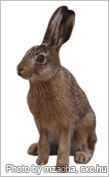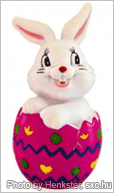It's almost impossible to see any Easter decoration that doesn't include a smiling rabbit surrounded by colored eggs, candy, and other Easter symbols. Well, that rabbit is perhaps the most recognized Easter symbol of all - the Easter Bunny. Although it is such a huge part of the holiday, not many people know how this character came to be.

Photo by mzacha, sxc.hu
Like many other holiday symbols, the Easter Bunny has its roots in ancient traditions. In southwestern Germany, the population worshipped a fertility goddess named Eostre. In representations of the goddess, she was usually surrounded by such symbols of fertility as eggs and rabbits or hares.
When the people of Germany were introduced to Christianity, they kept some of their earlier customs. Since Easter falls around the beginning of spring, it aligned with the traditional time period of a festival honoring Eostre. Eventually, the holiday came to be named after the goddess. In addition to lending her name to the holiday, her association with the hare came to symbolize the holiday as well.
Starting the TraditionBy the 1800s, the Easter Bunny had taken on quite a life of its own. Known as the Osterhase in Germany, children would make fake nests to attract the Easter Bunny. On the night before Easter, this mysterious character would leave colored eggs, candy, and toys behind. This, of course, brings up another Easter tradition - Easter eggs. Although rabbits and hares dig holes to make their nests, they don't lay eggs. But, there are some types of birds, like plovers and lapwings, that make their nests in holes in the ground. People coming upon the birds' nests connected them to the similar-looking rabbit nests. And that's how the Easter Bunny came to be associated with eggs.
The Easter Bunny in America

Photo by Henkster, sxc.hu
When German settlers came to the U.S. in large numbers in the 1700s, they brought the legend of the Easter Bunny with them. The tradition soon spread, and children across the country were creating nests for the Easter Bunny to leave its gifts in. Eventually, people started manufacturing ready-to use nests - the modern Easter basket.
The Easter Bunny has become such a symbol of Easter, much like the relation between Santa Claus and Christmas. In the weeks leading up to Easter, shopping malls often have someone dressed up as the Easter Bunny, and parents can take pictures of their children with the character.
The Easter Bunny also appears in various edible incarnations, the most popular being in chocolate form. Many Easter decorations include tributes to the Easter Bunny, whether it is represented as a real rabbit, a cartoon rabbit, or an anthropomorphic rabbit.
The Easter Bunny has gone through quite a transformation over the years. It started out as the pet of an obscure goddess, and it is now a smiling symbol recognized the world over. Whatever form it takes, the Easter Bunny has firmly cemented its role in the celebration of Easter.